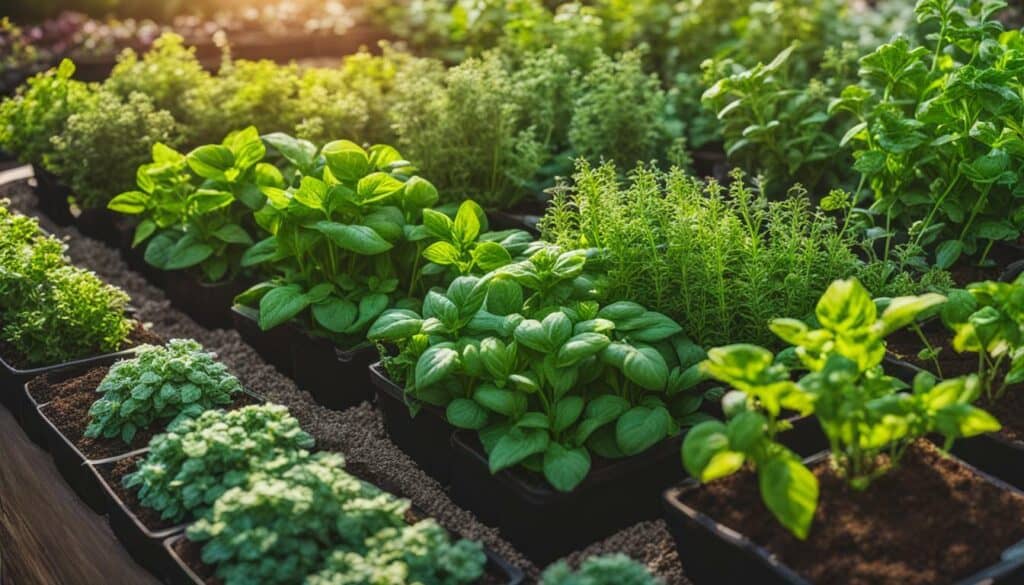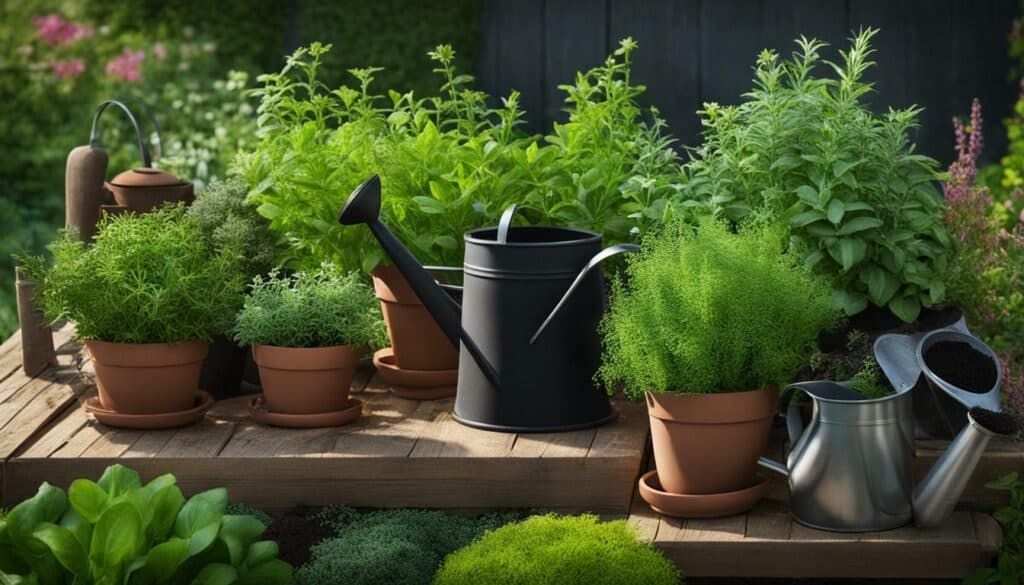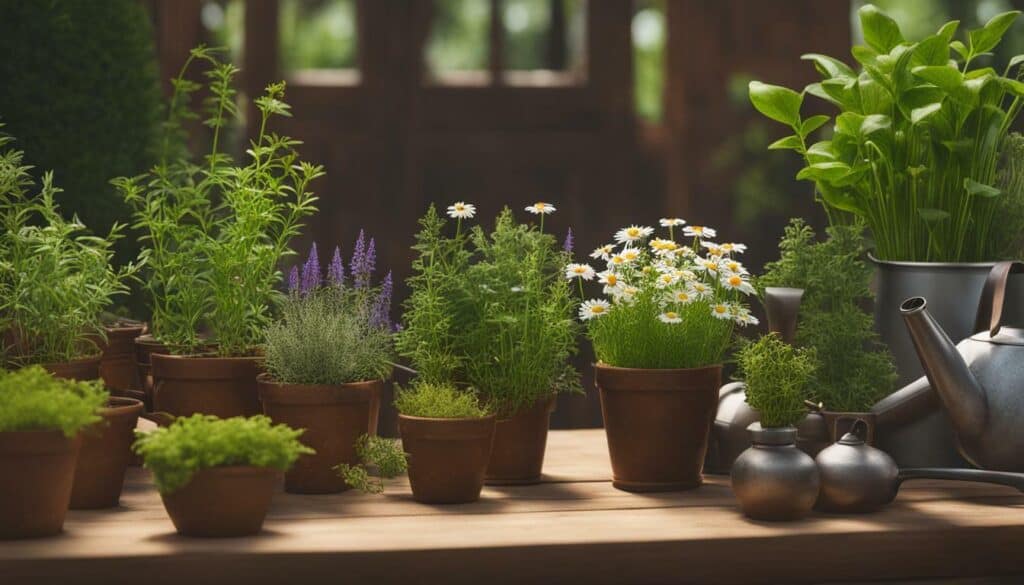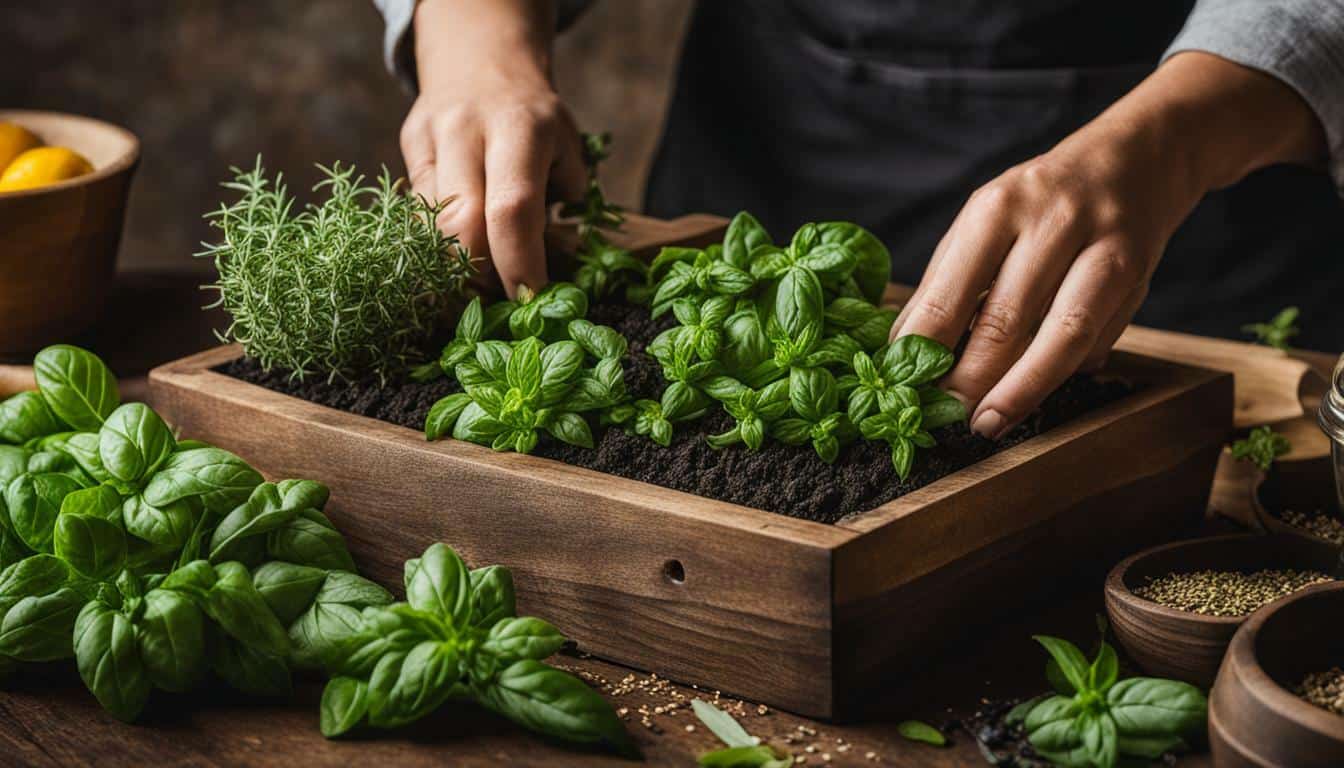Herbs are one of the easiest plants to grow in the garden, requiring low-maintenance and giving lots of harvests. Herb gardening is a great way to add fresh flavors to your meals while providing a convenient source of herbs right at your fingertips. Not only do homegrown herbs have increased flavor, but they also offer higher nutritional value compared to store-bought varieties.
Starting with herb gardening is an excellent way to get your foot in the door when it comes to gardening. With minimal care requirements, it’s an easy way to try out your green thumb before progressing to more challenging plants.
If you’re new to herb gardening, it’s essential to choose the right herbs for your garden, as some herbs require specific growing conditions to thrive. Understanding the unique needs of each herb is vital to create the ideal growing environment in your garden.
Key Takeaways:
- Herbs are easy to grow and require minimal care.
- Growing your own herbs offers increased flavor and nutrition compared to store-bought varieties.
- Choosing the right herbs for your garden is essential for successful herb gardening.
Why Grow Your Own Herbs?
Growing your own herbs allows for fresher flavors and more nutrient-rich plants. Herbs have a lot of unique benefits, making them one of the easiest plants to grow in the garden, perfect for beginner gardeners. With low-maintenance requirements, herbs can be harvested almost immediately after planting. They don’t require a lot of sunlight or nutrients and can grow in limited spaces, which is great if you have a small yard or only a balcony.
One of the biggest advantages of growing your own herbs is that you can enjoy fresher herbs with more potent flavors. You can also dry herbs at home and preserve them for later use, which ensures you always have your favorite herbs on hand. Store-bought herbs are often dried out and lose their freshness and flavor over time. When you grow your own herbs, you can harvest them at the peak of their flavor, and use them immediately for your culinary creations.
Another advantage of growing your own herbs is that you can harvest from most herb plants again and again, making the most of every plant in your garden. This also makes it more economical in the long run, as it will save you money from always having to buy herbs from your local grocery store.
Having an herb garden also allows you to have a more garden-to-table lifestyle. You can easily pot up some herbs or create an outdoor herb garden that you can conveniently dash out to, cut some sprigs, and bring them indoors to use in your cooking. It’s a great way to connect with nature and enjoy the satisfaction of harvesting from your own garden.
There are many different herbs to choose from, each with their own unique growing needs. Some popular options include anise hyssop, basil, chamomile, chives, cilantro, dill, lavender, oregano, parsley, rosemary, sage, and thyme. Herbs can be categorized into different plant families, such as the mint family, carrot family, daisy family, and onion family. Understanding the growing needs of each family can help you successfully grow the herbs you desire.
Most herbs are annuals or perennials. Annual herbs complete their life cycle in one season and need to be planted by seed each year, while perennials continue growing throughout the entire year in moderate climates or go dormant and come back from their roots in colder areas. Herbs are easy to grow and maintain, making them an ideal starting point for beginner gardeners. Starting with herbs can build confidence before moving on to more challenging plants.
Growing your own herbs not only provides you with fresh and flavorful ingredients for your culinary creations but also allows you to connect with nature and enjoy the satisfaction of harvesting from your own garden. So, why not start your herb garden today and enjoy the benefits of homegrown herbs?
Must-Have Herbs for Beginners
The best herbs to plant in an herb garden include anise hyssop, basil, bay laurel, calendula, chamomile, chives, cilantro/coriander, cumin, dill, echinacea, fennel, feverfew, lavender, lemon balm, marigold, marjoram, mint, oregano, parsley, rosemary, sage, stevia, summer savory, tarragon, thyme, and winter savory. These herbs provide a range of flavors and aromas for culinary use, as well as medicinal properties.
As a beginner, it is important to understand the unique growing requirements for each herb. Herbs belong to different plant families, such as the mint family or the onion family, and have specific needs for soil, water, and sunlight. For example, herbs from the carrot family, including cilantro and dill, prefer cooler weather and deeper soil, while herbs from the mint family, like basil and rosemary, thrive in dryer conditions and shallow containers.
Annual and perennial herbs also have different life cycles. Annual herbs, including cilantro and dill, complete their life cycle in one season and require reseeding each year. Perennial herbs, such as rosemary and thyme, continue growing throughout the year in moderate climates or go dormant in colder regions.
Regardless of the specific requirements, herbs are easy to grow compared to other plants and are perfect for beginners. They take up less space, require only a few hours of sunlight, and are ready for harvest quickly. Starting an herb garden with these must-have herbs can help build confidence before moving on to more challenging plants.

Overall, including these essential herbs in your herb garden will provide a variety of flavors and aromas for culinary use and medicinal purposes. Understanding the specific growing requirements for each herb will help ensure a successful harvest, even for beginners in gardening.
Understanding Herb Families
Herbs can be categorized into different plant families: mint family, carrot family, daisy family, and onion family. Understanding the unique characteristics of each family is crucial for successful herb gardening.
| Herb Family | Examples of Herbs | Growing Requirements |
|---|---|---|
| Mint Family | Basil, Rosemary, Mint | Prefer dryer conditions and shallow containers. |
| Carrot Family | Cilantro, Parsley, Dill | Thrives in cooler weather and moist soil. |
| Daisy Family | Chamomile, Marigold, Echinacea | Flowering herbs that need full sun and well-drained soil. |
| Onion Family | Chives, Garlic, Shallots | Easy to care for and require well-drained soil and full sun. |
Herbs can be annuals or perennials, with basil being a popular annual herb and mint herbs being perennials. Annual herbs, such as basil, complete their life cycle in one growing season, while perennials, such as mint, come back year after year.
Overall, herbs are a great starting point for beginner gardeners due to their ease of care and high success rate. Understanding herb families will help in planning an herb garden and maximizing the flavor and nutrition of homegrown herbs.

Mint Family Herbs
Mint family herbs, like basil and oregano, prefer dryer conditions and shallow containers, making them easy herbs to grow in your home garden. Considered some of the most flavorful herbs, mint family herbs including anise hyssop, lavender, lemon balm, marjoram, rosemary, sage, thyme, summer savory, and winter savory provide a wide range of flavors to enhance any dish.
One of the best characteristics of mint family herbs is their ability to regrow after being cut, allowing for a constant supply of fresh herbs. These herbs also provide high nutritional value, making them a healthy addition to any meal. To care for mint family herbs, ensure they receive plenty of sunlight and well-draining soil. Trim regularly to promote growth and prevent leggy or woody stems.

When planting mint family herbs, consider growing them in containers with shallow roots to allow for adequate aeration and drainage. Add a layer of pebbles to the bottom of the container to aid in drainage and use a quality potting mix to provide essential nutrients. Mint family herbs also make great companions to other plants in your garden, as their fragrant leaves can repel pests and attract beneficial insects.
If you’re new to herb gardening, mint family herbs are a great place to start. Their ease of growth and versatility make them ideal for beginners looking to add fresh flavors to their meals. Plus, they add a beautiful touch of greenery to any garden space.
Carrot Family Herbs
Carrot family herbs, like cilantro and parsley, prefer cooler weather and more moisture in the soil. They are easy to grow and offer quick harvests and flavorful results. Other herbs in this family include cumin, dill, and fennel.
Daisy family herbs provide a variety of flowering plants, such as chamomile, calendula, echinacea, and marigolds. These herbs are known for their edible flowers and are commonly used in teas and medicines.
The Mint plant family is known for its cut-and-come-again varieties, such as basil, lavender, lemon balm, and oregano. These herbs can be harvested repeatedly and are ideal for containers.
Chives, from the Onion Family, are easy to grow and pair well with other herbs like rosemary and thyme.
The definition of an herb includes plants that add flavor or nutrition to food or medicine. They usually require two to four hours of sunlight. Some herbs are annuals, such as dill and cilantro, while others are perennials like rosemary and thyme. Herbs are relatively easy to grow, making them a great starting point for beginner gardeners.
By growing your own herbs, you can enhance your culinary creativity and cut down costs in the kitchen. There are various resources available, such as books and guides, to help you plan and design your herb garden. Overall, growing carrot family herbs can be a rewarding and flavorful experience.

Daisy Family Herbs: Adding Edible Flowers to Your Herb Garden
Daisy family herbs, like chamomile and calendula, have edible flowers but take longer to produce. However, they are still an excellent choice for herb gardeners who want to add flavor and nutrition to their dishes.
When it comes to growing herbs, daisy family plants may not be the first ones that come to mind. However, these beautiful plants that belong to different plant families are easy to grow and add a splash of color to your herb garden.
Chamomile is a popular herb from the Daisy Family, which is known for its calming effect and is often used as a tea. Another herb from this family is calendula, which has a long history of use in traditional medicine for its anti-inflammatory properties.
Echinacea is also a member of the Daisy Family and is known for its immune-boosting properties. It can be used as a tea, tincture, or in a variety of herbal remedies.
Overall, growing daisy family herbs is a great way to add diversity and unique flavors to your herb garden. These herbs are generally easy to grow and maintain, making them a great choice for beginner herb gardeners.

If you’re interested in learning more about growing herbs, check out the book “The Essential Herb Gardening Handbook. It offers comprehensive guidance on growing, harvesting, and using herbs in your cooking and medicine.
Onion Family Herbs: Growing Essentials
Onion family herbs, like chives, are easy to grow and match well with other herbs. The Allium family is a popular group of herbs due to their low-maintenance nature and limited space requirements. Some of the most popular herbs in this family include garlic, chives, and onions. Chives, for example, are easy to plant and maintain, making them a great option for beginners.
Aside from the Allium family, there are other herb families to consider. The Mint family, for example, includes herbs like basil, lavender, and rosemary, which prefer dryer conditions and can be grown in containers. The Carrot family includes herbs like cilantro and dill, which prefer cooler weather and more moisture in the soil. The Daisy family includes herbs like chamomile and calendula, which have edible flowers and are often used in teas and medicines.
When growing herbs, it’s important to understand the difference between annuals and perennials. Annual herbs, like basil, complete their life cycle in one season and need to be replanted each year. Perennials, on the other hand, can continue growing for multiple years. Herbs in the Mint family, for example, are typically perennials.
Growing your own herbs has numerous benefits, aside from being easy and convenient. You get fresh and flavorful ingredients for cooking, with added nutritional value compared to store-bought varieties. Herbs can also be harvested multiple times, maximizing the use of each plant in your garden. Whether you’re a beginner gardener with limited space or an experienced gardener looking to expand your skills, herbs are a great starting point to grow your own food and add flavor to your meals.
Before planting your herb garden, it’s important to consider the unique growing needs of each herb. Understanding the characteristics and preferences of different plant families can help you create a thriving herb garden. With these growing essentials in mind, you’re ready to start planning and planting your very own herb garden.
Exploring Herb Types
Herbs are defined as plants that add flavor or nutrition to food or medicine and often have small space requirements. When it comes to herbs, there are several reasons why you should consider growing your own. First, herbs are easy to grow and require low maintenance. They can thrive in limited space and give you bountiful harvests almost immediately after planting. Additionally, herbs you grow yourself have more flavor and nutrients compared to store-bought varieties. Furthermore, most herb plants can be harvested again and again, maximizing their use in your garden.
To start an organic herb garden, it’s important to learn about the different types of herbs. Some of the best herbs to grow in an herb garden include anise hyssop, basil, bay laurel, calendula, chamomile, chives, cilantro/coriander, cumin, dill, echinacea, fennel, feverfew, lavender, lemon balm, marigold, marjoram, mint, oregano, parsley, rosemary, sage, stevia, summer savory, tarragon, thyme, and winter savory. These herbs can be categorized into different plant families, each with its own unique growing needs.
The mint plant family, also known as the Lamiaceae family, includes herbs like basil, lavender, lemon balm, oregano, rosemary, sage, thyme, and various types of mint. These herbs prefer dryer conditions and can be grown in containers with shallow roots.
The carrot family, or the umbellifer or Apiaceae family, includes herbs like cilantro, cumin, dill, fennel, and parsley. These herbs prefer cooler weather and more moisture in the soil.
The daisy family consists of chamomile, calendula, echinacea, and marigold. These flowering herbs are often used in teas and medicines and have edible flowers.
The onion family, or the Amaryllidaceae family, includes chives. Chives are easy to grow and share similar growing conditions with other herbs like rosemary, oregano, and thyme.
What defines an herb is a plant that contains a plant part (seeds, flowers, leaves) that adds flavor or nutrition to food or medicine. Most herbs require minimal space in the garden and can grow with just 2 to 4 hours of sunlight. Annual herbs, like dill and cilantro, complete their life cycle in one season and need to be replanted each year. Perennial herbs, on the other hand, can continue growing and may even become bushes or small trees.
Some herbs are easier to grow than others. Basil, thyme, and oregano are considered easy to grow and can be kept alive throughout the year. Sage and rosemary may require a bit more care.
In conclusion, exploring herb types allows you to discover a wide range of plants that can add flavor and nutrition to your meals. By growing your own herbs, you can enjoy the benefits of fresh, flavorful, and nutrient-rich ingredients right from your garden. Whether you have a large backyard or just a windowsill, herb gardening is an accessible and rewarding hobby for anyone to explore.
Annual vs. Perennial Herbs
Annual herbs, like dill and cilantro, complete their life cycle in one season and need to be replanted each year. This makes them a great option for those who want to experiment with different herbs each year or want to ensure their herb garden remains fresh and new each season. Perennial herbs, on the other hand, can grow throughout the year in suitable climates or go dormant during colder seasons and regrow from their roots. This means that they can provide a steady supply of flavorful herbs, even if you live in an area with harsher winters.
When it comes to growing herbs, it’s essential to consider the unique needs of each herb family. For instance, herbs from the mint family, such as rosemary, oregano, and thyme, are typically perennial and can thrive in dryer conditions. They also have shallow roots, which makes them perfect for growing in containers. On the other hand, herbs from the carrot family, like cilantro and dill, prefer cooler weather and more moisture in the soil. Flowers herbs, such as chamomile and calendula, are part of the daisy family and are typically harvested at the end of the plant’s life cycle. Understanding the distinct growing needs of each herb is critical to ensure your garden flourishes.
It’s worth mentioning that the ease of growing herbs can vary. Basil, for example, is one of the easiest herbs to start from seed, while herbs like sage and rosemary can be a bit more challenging. However, overall, herbs are generally easy to grow and are a great starting point for beginner gardeners.
Ultimately, whether you choose to grow annual or perennial herbs depends on your climate, growing conditions, and personal preferences. Both categories offer a range of flavorful and nutritious herbs that can enhance your culinary creations. Growing your own herbs allows you to have a garden-to-table lifestyle, enjoy the freshness and flavor of homegrown herbs, and make the most of every plant in your garden.

As you plan your herb garden, consider the needs of each herb and determine whether annual or perennial herbs are the best fit for your garden. Remember to choose a location with plenty of sunlight, and be sure to water your plants regularly. With a bit of patience and care, your herb garden will provide you with flavorful and nutritious herbs for years to come.
Recommended Resource
If you’re seeking to grow your herb garden and become a culinary artist, look no further than “The Essential Herb Gardening Handbook”. This comprehensive guide provides everything you need to know, from basic principles to advanced techniques like companion planting and propagation.
The book also includes cheat sheets for 20 beloved herbs, as well as planning and design guides for any space and checklists of companion herbs. Additionally, you’ll find solutions to common gardening problems, techniques to improve soil, and favorite recipes for each herb.
Whether you’re new to gardening or have limited space, this guide will help you grow herbs and create flavorful meals. The Essential Herb Gardening Handbook” provides guidance on growing herbs, designing herb gardens, companion planting, soil improvement, and troubleshooting common gardening problems. I highly recommend it for any aspiring herb gardener!

Conclusion
In conclusion, mastering herb gardening basics opens up a world of fresh flavors and culinary possibilities right in your own backyard. Growing your own herbs offers numerous benefits, including minimal maintenance, abundant harvests, and superior flavor and nutrient content compared to store-bought varieties.
Some of the best herbs to plant in an herb garden include anise hyssop, basil, bay laurel, calendula, chamomile, chives, cilantro/coriander, cumin, dill, echinacea, fennel, feverfew, lavender, lemon balm, marigold, marjoram, mint, oregano, parsley, rosemary, sage, stevia, summer savory, tarragon, and thyme.
Each herb belongs to a different plant family, each with its own unique growing requirements. For example, the mint plant family, known as Lamiaceae, includes the best cut-and-come-again varieties, while the carrot family, known as Apiaceae, includes common kitchen herbs. The daisy family includes flowering herbs, while the onion family comprises the easiest herb to grow, chives.
An herb is any plant part, such as seeds, flowers, or leaves, that adds flavor or nutrition to food or medicine. Most herbs take up a relatively small space in the garden and require 2 to 4 hours of sunlight.
Annual herbs, also known as soft herbs, complete their life cycle in one season, while perennials continue growing throughout the year or go dormant in colder climates. Basil is one of the easiest herbs to grow, while thyme, oregano, sage, and rosemary may be slightly more challenging. However, overall, herbs are relatively easy to grow compared to other plants. Starting with herbs is recommended for new gardeners before moving on to more demanding plants.
The Essential Herb Gardening Handbook and other resources provide valuable information and techniques for successful herb gardening.
Whether you have a large garden or just a windowsill, anyone can start growing herbs and enjoying the benefits of homegrown flavors. So start your herb garden today and embrace the joys of garden-to-table cooking!
What Are Some Tips for Growing Basil in a Herb Garden?
If you want to grow your own basil garden, here are a few tips. First, choose a sunny location with well-draining soil. Basil loves warmth and requires at least six hours of sunlight daily. Make sure to water it consistently, keeping the soil moist but not waterlogged. Remember to pinch off the top leaves to encourage bushier growth. Ultimately, your efforts will yield a thriving basil garden.
FAQ
Q: Why should I grow my own herbs?
A: Growing your own herbs allows you to enjoy fresher flavors and more nutrient-rich plants.
Q: What are the best herbs to plant in an herb garden?
A: The best herbs for an herb garden include anise hyssop, basil, bay laurel, calendula, chamomile, chives, cilantro/coriander, cumin, dill, echinacea, fennel, feverfew, lavender, lemon balm, marigold, marjoram, mint, oregano, parsley, rosemary, sage, stevia, summer savory, tarragon, thyme, and winter savory.
Q: How are herbs categorized into different plant families?
A: Herbs can be categorized into different plant families, such as the mint family, carrot family, daisy family, and onion family.
Q: What are mint family herbs?
A: Mint family herbs, like basil and oregano, prefer dryer conditions and shallow containers.
Q: What are carrot family herbs?
A: Carrot family herbs, like cilantro and parsley, prefer cooler weather and more moisture in the soil.
Q: What are daisy family herbs?
A: Daisy family herbs, like chamomile and calendula, have edible flowers but take longer to produce.
Q: What are onion family herbs?
A: Onion family herbs, like chives, are easy to grow and match well with other herbs.
Q: What is the difference between annual and perennial herbs?
A: Annual herbs, like dill and cilantro, complete their life cycle in one season and need to be replanted each year. Perennial herbs, like rosemary and thyme, can continue growing year-round in moderate climates or go dormant in colder climates.
Q: What is a recommended resource for herb gardening?
A: The Essential Herb Gardening Handbook” provides guidance on growing herbs, designing herb gardens, companion planting, soil improvement, and troubleshooting common gardening problems. It also includes favorite recipes for each herb.
Source Links
- https://www.gardenary.com/blog/the-ultimate-guide-to-growing-herbs
- https://www.amazon.com/Essential-Herb-Gardening-Handbook-Sustainable/dp/1778002935
- https://www.amazon.com/Essential-Herb-Gardening-Handbook-Flavors/dp/B0B1N8G7HX
- https://extension.wvu.edu/lawn-gardening-pests/gardening/gardening-101/herb-gardening-for-beginners
- https://www.amazon.com/Herb-Gardening-Beginners-Culinary-Medicinal/dp/1638785910
- https://www.daviddomoney.com/how-to-grow-a-beginners-herb-garden/
- https://howtoculinaryherbgarden.com/herb-gardening-for-beginners/
- https://bootsandhooveshomestead.com/herb-gardening-for-beginners/
- https://www.gardenary.com/blog/how-to-start-an-herb-garden
- https://plantsforallseasons.com/herb-gardening-basics/
- https://www.gardenerbasics.com/blog/mint-companion-plants
- https://www.gardenersbasics.com/tools/blog/best-companion-plants-for-peppermint-herb
- https://www.buncombemastergardener.org/vegetables-carrot-family-apiaceae-roots-herbs/
- https://www.almanac.com/plant/carrots
- https://blog.mountainroseherbs.com/botany-carrot-family
- https://www.clovegarden.com/ingred/dy_herbs.html
- https://www.gardenerbasics.com/blog/herbs-annual-and-perennial-list
- https://www.jekkas.com/blogs/jekkas-blog/all-about-alliums-chives-garlic-and-onions
- https://www.herbsociety.org/hsa-learn/herb-information/herb-gardening-basics.html
- https://www.homedepot.com/c/ai/herb-gardening-guide-for-beginners/9ba683603be9fa5395fab901a017fe5c
- https://kidsgardening.org/resources/garden-activities-exploring-herbs/
- https://www.notjustahousewife.net/growing-herbs-annual-vs-perennial-herbs/
- https://todayshomeowner.com/lawn-garden/guides/annual-and-perennial-herbs-for-your-garden/
- https://www.rogersgardens.com/blogs/current-news-events/the-art-and-science-of-growing-herbs-a-beginners-guide
- https://www.herbcottage.com.au/pages/how-to-start-a-herb-garden





Leave a Reply